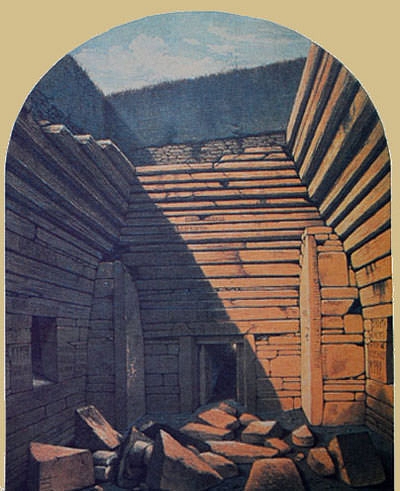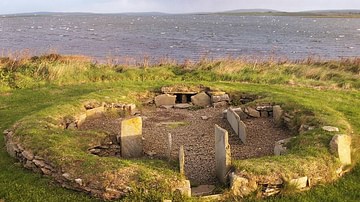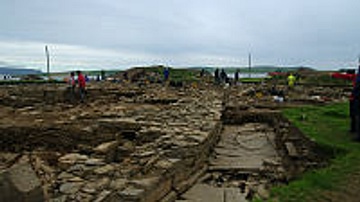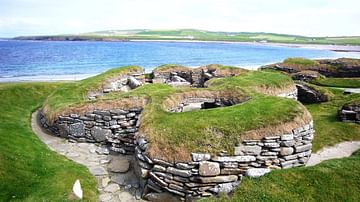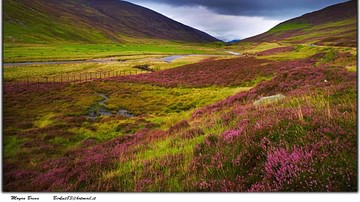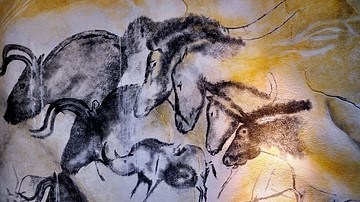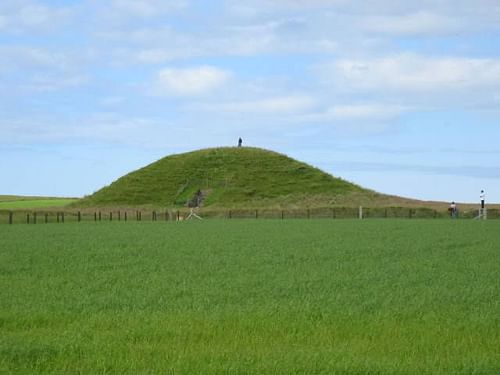
Maeshowe (pronounced `maze-ow' or `maze-oo') is a large Neolithic chambered cairn, dating from between 3000-2800 BCE, in the Stenness parish of Orkney, Scotland. According to Dr. Berit Sanders, of Lund University, the name means `Meadow Mound' and comes from Old Scandinavian; the present location of both Maeshowe and the nearby site of the Maesquoy Standing Stones are thought to have originally been meadows (Orkneyjar.com). The construction of the cairn, and the long passage leading into it, has led scholars to also designate the site a passage grave even though no significant human remains (only traces of bone fragments and a skull portion) have been found at the site. Maeshowe is located in proximity to many other famous Neolithic sites in Orkney such as the Barnhouse Settlement and Barnhouse Stone, The Standing Stones of Stenness, The Ness of Brodgar, The Ring of Brodgar, The Watchstone, Cometstone, and The Unstan Cairn and, to the north-west, The Ring of Bookan and the village of Skara Brae.
The site was first excavated in July 1861 CE by the antiquarian James Farrer, on the recommendation of Mr. David Balfour, known for his work at Skara Brae, and others who also worked at Skara Brae such as Mr. George Petrie. Citing Petrie's measurements, Farrer described the exterior of the cairn thusly (metrics added): “The tumulus is about 92 feet (28 metres) in diameter, 36 feet (11 metres) high, and about 300 feet(91 metres) in circumference at the base. It is surrounded by a trench 40 feet (12 metres) wide, and varying in depth from 4 to 8 feet (1-2 metres). It is situated on the north side of the new road leading to Stromness from Kirkwall, being about 6 miles (9 km) from the former, and 9 (14 km) from the latter place. It is about 200 yards distant from the road and a mile and a half (2.4 km) from the Stones of Stenness” (guternberg.org). Farrer found the entrance passage blocked with rubble and, apparently at the suggestion of Petrie, dug down through the top of the mound (a choice which has been criticized by archaeologists since). At this time the mound was conical in shape but, when the site was taken under government care in 1910, a concrete roof was added (in part to close the cavity made by Farrer) and the mound shaped to its present form (Orkneyjar.com). Maeshowe is considered one of the finest examples of Neolithic architecture and has given its name to similarly constructed tombs stretching from Papa Westray and Sanday islands in the north down through mainland Orkney. The cairn was declared a World Heritage site in 1999 and is presently under the care of Historic Scotland.
As with many Neolithic sites, Maeshowe is aligned to the midwinter solstice and the setting sun at that time of year brightly illuminates the entrance passage and main chamber. That the cairn was built on the site of a much older structure is attested to by the find of a socket hole near the mound which suggests a stone circle once stood at the location. The trench surrounding the cairn seems similar to that surrounding other henges such as the nearby Ring of Brodgar. The nearby monolith known as the Barnhouse Stone is aligned directly with the entrance passage of Maeshowe and, at the winter solstice, the sun sets over the top of that stone monument to then illuminate the cairn. It is possible that the Barnhouse Stone was originally erected to perform the same function with a henge which once stood on the Maeshowe site and, if so, the builders carefully constructed the cairn to align to the earlier site of Barnhouse (built circa 3300). Alternately, it has been suggested, the Barnhouse Stone may have been erected during the construction of Maeshowe and the earlier structure at the site was a house or ritual site instead of a henge. Support for this theory comes from Structure Eight at the Barnhouse Settlement (built 2600 BCE) which seems to have been built for ritual purposes and, like Maeshowe, raised on a platform of clay. It has been suggested that Structure Eight may have been raised to replace whatever structure originally occupied the Maeshowe location. Whatever the original building, the current cairn is so precisely constructed that, twenty-two days before and after the winter solstice, the sun sets and then reappears from nearby Hoy's Ward Hill (directly in line with the Barnhouse Stone) to create what investigators of the phenomenon call `Solar Flashings' – flashes of light thrown into the entrance passageway and the main chamber. These flashes are not the prolonged illumination of the solstice and it has been suggested that the cairn was built purposefully to catch this light intermittently leading up to, and away from, midwinter to perhaps symbolize the coming of warmer, brighter, days.
The entrance passage, on the south-west side of the mound, runs 36 feet (11 metres) to the main chamber and includes the interesting feature of the so-called `blocking stone', a huge hewn rock which could be pulled from a recess in the wall to close off the passage, perhaps during rituals. The main chamber measures 13 feet (4.7 metres) with stone buttresses in the corners which once supported a corbelled roof (which the drawings of a Mr. Gibb of Aberdeen, who was a member of Farrer's 1861 CE expedition, show had fallen in before that time). Runic inscriptions (the largest single grouping found so far in the world) as well as the engraving of a dragon are cut in the walls of this chamber and date to the 12th century CE when a band of Norsemen took refuge in the cairn during a winter storm. This same group may have carried off whatever valuables or remains were housed in the main chamber or the three smaller ones which branch off from it (to the east, north, and west). The Orkeyinga Saga (written c. 1230 CE) describes the cairn being looted by the Norse Earl Harald Maddadarson and Ragnvald, Earl of More, sometime in the 12th century CE. As there is much in the Orkneyinga which scholars now consider legendary, it cannot be said with certainty that these particular men, or any men, broke in and looted the tomb. Farrer certainly seemed to think they did, writing in 1862 CE that, “[The Cairn has] undoubtedly been entered at some remote period, probably by the Northmen, who, as is well known, were not deterred by feelings either of religion or superstition, from opening and ransacking any place likely to repay them for their trouble. Whether they were the first to break into the building, or whether they found it in a state of comparative ruin, the natural result of great antiquity, can now only be matter of conjecture” (gutenberg. org).
Besides the testimony of the Orkneyinga Saga, the persistent claim that there were once valuables housed in the cairn is suggested by some of the runic graffiti which mentions a `great treasure' which was taken away from the site but, also, a great treasure buried close by the site. Whether there ever was any such treasure no one knows and the idea that Maeshowe once contained human remains, and attendant wealth for the afterlife, is pure speculation on the part of modern excavators based on these evidences and the excavators' assumptions of what the cairn may have once held. The only artifacts discovered by the 1861 CE party were bones of horses and a part of a human skull. No physical evidence exists to support the claim of a great treasure in the building nor even that it was a tomb. Further, it has been noted, the word `treasure' could have easily meant something quite different to an ancient community than it does to a more modern one. The Grooved Ware pot, found in Structure Eight of the Barnhouse Settlement, contained fourteen pieces of flint, a type of stone highly valued in Orkney owing to its rarity and “a quantity that would have been regarded as a treasure hoard at the time” (Orkneyjar.com).
The fact that the `blocking stone' at Maeshowe had to be pulled into place from inside, not outside, the entrance passage, suggests that it was used to seal off the cairn during rituals of some kind and the midwinter solstice alignment further supports the function of the site as ceremonial in nature. The location of the cairn, aligned to the Barnhouse Stone, in proximity to Structure Eight and, most significantly perhaps, to the recently excavated site of the Ness of Brodgar, which most certainly was a ritual complex, lends greater support to the theory that Maeshowe was used in this same capacity. As further excavation proceeds on the Ness of Brodgar, and surrounding areas which no doubt conceal more ancient structures, the original purpose of the cairn of Maeshowe may be better understood.
